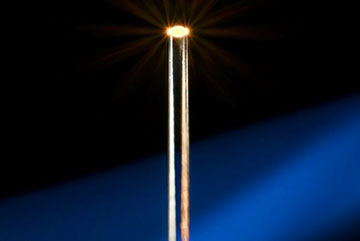
Researchers at Eindhoven University of Technology have shown how to efficiently couple a photonic crystal cavity to the tip of an optical fiber, using the device to detect individual particles measuring just 50 nm across. [Image: Bart van Overbeeke]
Scientists in the Netherlands have combined nanophotonics and fiber optics to make a new kind of sensor for detecting nanoparticles (Optica, doi: 10.1364/OPTICA.516575). The device measures tiny variations in the wavelength of light reflected from a precisely fabricated photonic crystal, and the researchers say it could find applications in environmental monitoring and medicine.
Cavity catches light
Particles measuring just a few tens of nanometers across are found in everything from car exhaust to printer toner. They can be dangerous when inhaled, as they are able to penetrate deep into the lungs and have quite large surface areas―allowing them to absorb toxic compounds. Detecting these nanoparticles, however, currently requires bulky, expensive laboratory equipment.
Optical fiber is already used to measure a variety of physical and chemical parameters at a distance, since it is also immune to electromagnetic interference. But the sensors most often employed―fiber Bragg gratings―are not well suited to detecting localized environmental changes such as the presence of nanoparticles.
In the latest work, Arthur Hendriks, Andrea Fiore and colleagues at Eindhoven University of Technology attach a photonic crystal to the tip of a length of optical fiber. The crystal consists of a two-dimensional array of nanometer-sized air holes etched into a slab of semiconductor, with a cavity at its center formed by omitting three of the holes. The cavity traps light thanks to a photonic bandgap created by the periodic variation in refractive index. A particle coming close to the cavity changes the local refractive index very slightly, so altering the wavelength of the cavity―which can be measured from the spectrum of light reflected by the crystal.
Finding the best position
As the researchers explain, a hurdle that must be overcome when making such a device is improving the otherwise poor coupling between the fiber and photonic crystal cavity. Standard cavities leak most light at large angles, whereas single-mode fibers have small numerical apertures. The trick, Hendricks and colleagues say, is being able to arrange the crystal's holes so as to boost the coupling while also maximizing the cavity's quality (Q) factor—its ability to trap light over time—and minimizing the trapping volume, allowing it to detect small particles.
This optimization requires a huge amount of processing, as the position of each hole counts. The Eindhoven group has shown how to do this efficiently by using a gradient-based optimization program recently developed by researchers at Stanford University, USA.
The process involves working out how best to shift holes compared with their original position―each hole measuring about 100 nm across and spaced some 400 nm from its nearest neighbor―by inputting the shifted distances as variables into a function that combines the coupling with the Q-factor and mode volume (represented by the light's electric field at the center of the cavity). They then maximize the function for a given target Q-factor and confirm the optimization result using more conventional simulation software.
Carrying out between 20 and 30 iterations of the optimization process, they worked out that they should be able to significantly boost both the coupling efficiency and Q-factor of a photonic crystal cavity compared with a standard design with periodic holes. This would increase the coupling efficiency by more than an order of magnitude.
The researchers then tested their design in the lab, using standard semiconductor fabrication to fashion photonic crystals from 250-nm thick pieces of indium phosphide and then employing a method they developed four years ago to attach the crystals to the tips of single-mode fibers. They then bounced light from a superluminescent diode off the cavities, measured the reflected spectra and compared those with one obtained by replacing the cavities with a fiber optic retroreflector. The measured Q-factors were lower than those obtained from the simulation, but the team still managed to obtain a combination of Q-factor, coupling efficiency and field localization unmatched by other fiber-tip sensors.
With that basic demonstration under their belt, Hendriks and his team used their sensor to try to detect two sizes of amine-coated polystyrene nanoparticles suspended in water, one measuring 200 nm across and the other just 50 nm. They were successful in both cases—by negatively charging the sensor surface using an air plasma, they recorded a series of red shifts in the fiber's reflection spectrum.
The team still managed to obtain a combination of Q-factor, coupling efficiency and field localization unmatched by other fiber-tip sensors.
To confirm that these corresponded to nanoparticle detections, they used an electron microscope to image the photonic crystal at the end of the experiments and found the appropriate number of particles either in or next to the cavity. Indeed, the wavelength shifts, they say, corresponded to the typical distance of the respective particles from the cavity center.
Measuring air quality
The researchers’ next step is to apply their new technology to measure air quality in school classrooms as part of the Horizon Europe project called LEARN, an aim of which is to assess the impact of air quality on the health of children. This, they explain, will involve building a portable demonstrator that can be used to measure particle concentrations outside the lab.
They say that biomolecules could be next, since they have calculated that their experimental wavelength uncertainty―about 5×10-14 m―should allow them to detect particles as small as 12 nm across, as long as they can trap those particles in the middle of the cavity. As the researchers point out, large biomolecular complexes such as immunoglobulin or viruses can be as big as this.
Looking further ahead, Hendriks and colleagues envisage that by shrinking the cavity, further raising the Q-factor and improving the cavity's interrogation, it “could be possible to approach the fundamental thermodynamic limit and sense single biomolecules, such as antibodies or inflammatory proteins.”
